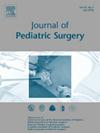Primary laparoscopic pull-through for Hirschsprung's disease in infants and children
Abstract
Between November 1993 and September 1994, 12 primary laparoscopic colon pull-through procedures were performed in infants and children. The patients' ages ranged from 3 days to 6 years. The primary diagnosis in all 12 patients was Hirschsprung's disease. All children had their operations without construction of preoperative or postoperative colostomy. Three 5-mm abdominal wall ports were used for access to the peritoneal cavity. The sigmoid colon and proximal rectum were mobilized laparoscopically. A submucosal sleeve was developed transanally to meet the dissection from above. The colon was then pulled down in continuity, divided above the transition zone, and secured to the anal mucosa 5 to 10 mm above the pectinate line. Mean postoperative stay was 4 days. Laparoscopic visualization provides clear delineation of pelvic structures even in small infants. Laparoscopic pull-through requires no more time than similar open procedures, averaging just over 2 hours. The morbidities associated with colostomy formation and closure and the inconvenience of colostomy care are avoided with a one-stage technique. These benefits combined with the advantages of minimally invasive surgery make primary laparoscopic pull-through a potential advance in the surgical treatment of Hirschsprung's disease.

 求助内容:
求助内容: 应助结果提醒方式:
应助结果提醒方式:


